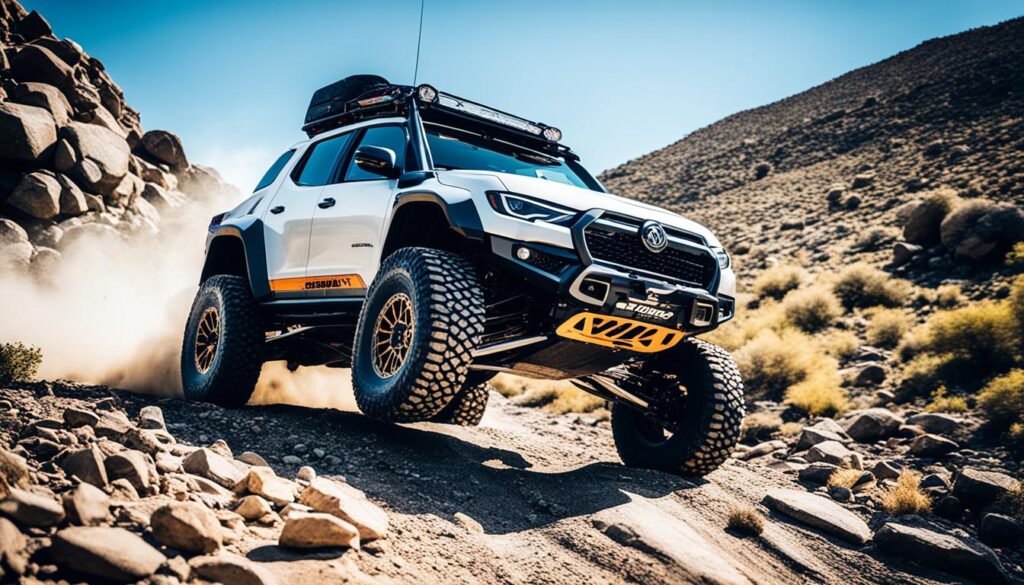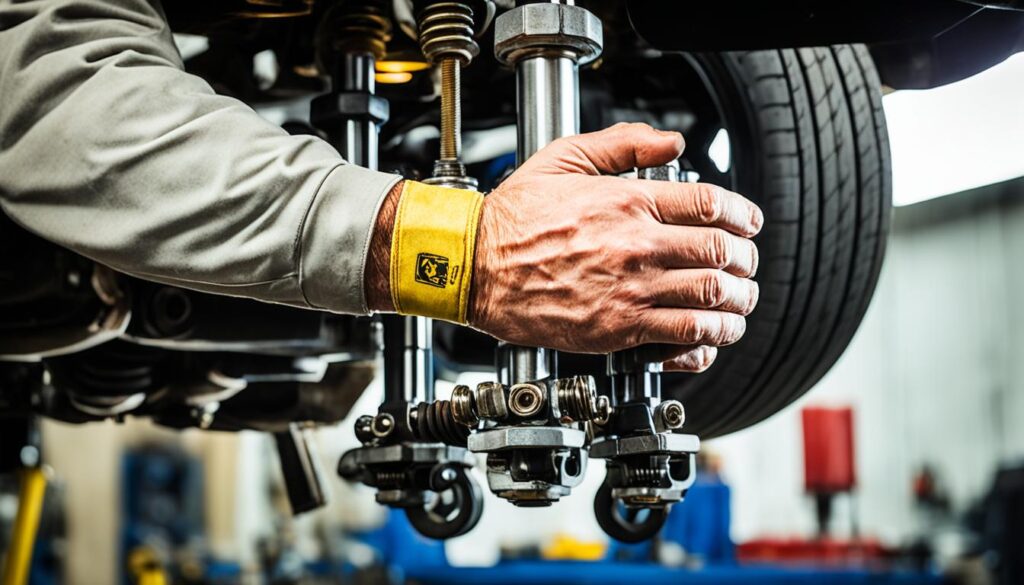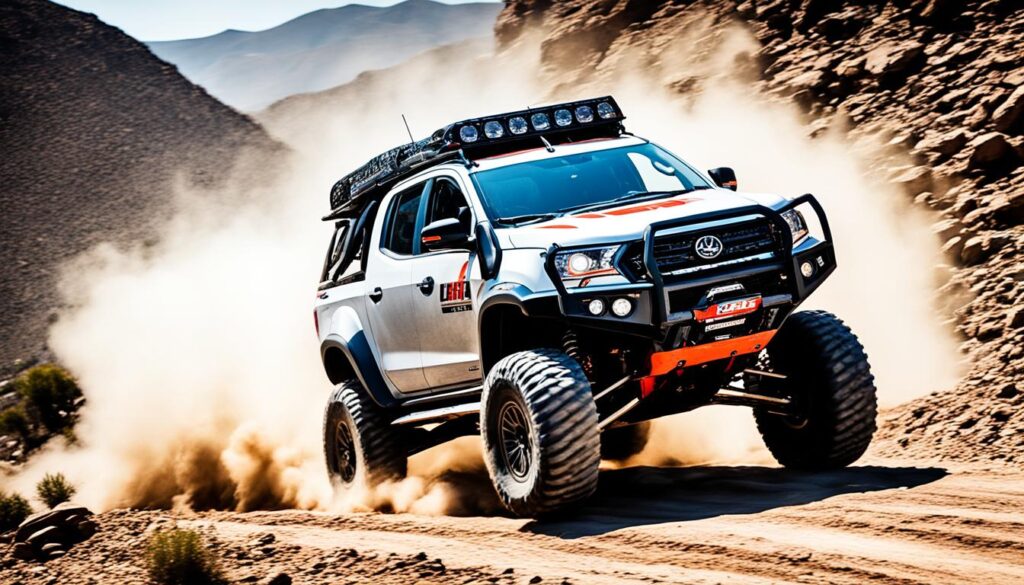Have you ever wondered how some vehicles effortlessly conquer rough terrains during overlanding trips? The secret lies in their suspension setup. An appropriate suspension system is the key to unlocking the full potential of your overlanding adventures. But what is the optimal suspension travel for an exhilarating off-road experience? Let’s dive into the world of overlanding suspension and uncover the answers.
Key Takeaways:
- Choosing the right suspension system is crucial for successful overlanding.
- Factors like weight, off-road conditions, and budget should be considered.
- There are different types of suspension systems available, each suitable for specific needs.
- Proper installation and regular maintenance are essential for optimal performance.
- An optimal suspension travel ensures stability, control, and comfort on rough terrain.
Contents
Factors to Consider When Choosing a Suspension System
When selecting a suspension system for your overlanding adventures, there are several crucial factors to take into account to ensure optimal performance. The right suspension will not only enhance your vehicle’s off-road capabilities but also provide a comfortable ride on rough terrain. Let’s explore the key considerations when choosing a suspension system for your off-road vehicle.
Weight and Load Capacity
The weight of your vehicle and the gear you typically carry during overlanding trips play a significant role in selecting the appropriate suspension system. Overloading your vehicle can strain the suspension and compromise its performance, leading to discomfort and potential damage. It’s essential to choose a suspension system that can handle the weight of your vehicle and gear without sacrificing performance or safety.
Terrain and Off-Road Conditions
The type of terrain and off-road conditions you typically encounter should also guide your suspension system selection. Different terrains require specific suspension setups to ensure optimal performance. For example, if you frequently navigate rocky terrain, a suspension system designed to handle high impacts and provide superior traction would be ideal. On the other hand, if your overlanding adventures take you through sand dunes, a suspension system that offers excellent traction and stability in loose sand will greatly enhance your off-road experience.
Budget and Desired Performance
Another critical factor to consider is your budget and the desired level of performance for your suspension system. High-performance suspension upgrades often come at a higher cost, but they can significantly improve your vehicle’s off-road capabilities and overall ride quality. Consider your budgetary constraints and aim for a suspension system that strikes the right balance between performance and affordability.
Suspension System Options
There is a variety of suspension systems available for overlanding vehicles, each designed to suit specific needs and preferences. Some popular options include:
- Off-Road Vehicle Suspension: Specifically engineered for off-road performance, these suspension systems offer enhanced durability and stability in rugged environments.
- Long-Travel Suspension: Designed to provide increased wheel travel, long-travel suspension systems are ideal for navigating challenging terrain and absorbing impacts.
- Suspension Upgrades for Overlanding: These upgrades focus on improving the overall performance of your vehicle’s suspension system for off-road adventures.

By carefully considering the weight, terrain, and budget, you can select a suspension system that optimizes your vehicle’s off-road capabilities and ensures a smooth and comfortable overlanding experience. Next, we’ll explore the different types of suspension systems available for overlanding vehicles.
Types of Suspension Systems for Overlanding
Choosing the right suspension system for your overlanding adventures is crucial to ensure optimal off-road performance and maximize suspension travel. There are several types of suspension systems available, each with its own unique benefits and characteristics.
Independent Suspension Systems
Allowing each wheel to move independently, independent suspension systems offer superior handling and a smoother ride on rough terrain. This type of suspension enhances traction and stability, providing greater control and comfort during off-road trips.
Solid Axle Suspension Systems
Known for their durability and stability, solid axle suspension systems are a popular choice among overlanders. These systems can withstand heavy loads and harsh conditions, making them ideal for long-distance off-roading adventures.
Coil Spring Suspension Systems
Offering a high degree of comfort, coil spring suspension systems are perfect for those seeking a smooth and enjoyable ride during long-distance overlanding trips. These suspension systems effectively absorb impacts and provide excellent articulation on uneven terrain.
Leaf Spring Suspension Systems
Leaf spring suspension systems are renowned for their durability and load-bearing capacity. Often used in heavier vehicles, they provide the strength necessary to support heavy loads while maintaining stability and control over rough terrains.
Air Suspension Systems
Using an airbag instead of traditional springs, air suspension systems provide adjustable ride height and comfort. With the ability to adapt to varying load conditions, these systems offer excellent control and a smooth ride on any terrain.
It is important to choose a suspension system that aligns with your specific needs, preferences, and intended use for your overlanding vehicle. Consider factors such as terrain types, load requirements, and desired ride comfort when making your decision. By selecting the best suspension for off-roading, you can maximize suspension travel and enhance your overall overlanding experience.
Summary:
In this section, we explored the different types of suspension systems available for overlanding. Independent suspension systems offer better handling and a smoother ride, while solid axle suspension systems provide durability and stability. Coil spring suspension systems offer comfort, and leaf spring suspension systems provide load-bearing capacity. Air suspension systems offer adjustable ride height and comfort. Choose the suspension system that suits your needs and preferences to maximize your off-road adventures.
Installation and Maintenance Tips for Overlanding Suspension
Proper installation and maintenance are essential for optimal suspension performance. When it comes to installing suspension for overlanding, it’s crucial to follow the manufacturer’s instructions carefully. The installation process may vary depending on the type of suspension, so having the necessary tools and equipment is essential.
Regular maintenance plays a significant role in ensuring that your suspension system functions correctly. By following a few simple steps, you can keep your suspension in top condition for your overlanding adventures. Here are some installation and maintenance tips:
- Follow the Instructions: It’s important to read and understand the installation instructions provided by the manufacturer. These instructions will guide you through the process and ensure that you install the suspension system correctly.
- Choose the Right Tools: Having the right tools for the job will make the installation process much easier. Make sure you have a complete set of tools, including wrenches, sockets, and torque wrenches.
- Inspect and Clean: Before installing the suspension, thoroughly inspect all components for any signs of damage or defects. Clean the components if necessary to ensure smooth operation.
- Grease and Lubricate: Apply a suitable grease or lubricant to the suspension components as recommended by the manufacturer. This will help reduce friction and prolong the life of the suspension system.
- Check for Proper Alignment: After installing the suspension, check for proper alignment to ensure that the suspension components are correctly positioned. Improper alignment can affect the performance and handling of your vehicle.
- Monitor for Wear and Damage: Regularly inspect your suspension system for any signs of wear or damage. Look out for leaks, cracks, or worn-out parts. Address any issues promptly to prevent further damage or failure.
- Follow Maintenance Schedule: Refer to the manufacturer’s recommended maintenance schedule for your specific suspension system. This may include periodic inspections, adjustments, and replacements of certain components.
- Consult a Professional: If you’re unsure about any aspect of the installation or maintenance process, it’s always best to consult a professional mechanic or suspension specialist.
By following these installation and maintenance tips, you can ensure that your suspension is in top condition, providing optimal performance and durability during your overlanding adventures.

Conclusion
In conclusion, having the right suspension setup is crucial for a successful and enjoyable overlanding trip. A high-performance off-road suspension provides numerous benefits, including improved capabilities, stability, and safety. It allows your vehicle to navigate challenging terrains with ease, absorbing impacts and providing a comfortable ride even on rough surfaces.
When choosing a suspension system for overlanding, consider important factors such as the weight of your vehicle and gear, the type of terrain you will encounter, and your budget. By carefully evaluating these factors, you can select the best suspension system that suits your specific needs and preferences.
Proper installation and regular maintenance are also vital to ensure optimal suspension performance. Follow the manufacturer’s instructions carefully during installation, and regularly inspect and lubricate suspension components to keep them in top condition.
Investing in a high-quality off-road performance suspension for overlanding is a wise decision. It maximizes your vehicle’s off-road capabilities, enhances stability and safety, and provides a smoother and more comfortable ride. With the right suspension, you can confidently tackle any terrain, including rocky trails, sandy dunes, and muddy paths, and have a truly memorable overlanding experience.
FAQ
Why is having the right suspension setup important for overlanding trips?
The right suspension setup is important for overlanding trips because it ensures your vehicle can handle rough terrain and heavy loads. It provides stability and control, absorbs impacts, and maintains contact between the tires and the ground.
What factors should I consider when choosing a suspension system for overlanding?
When choosing a suspension system for overlanding, consider the weight of your vehicle and gear, the type of terrain you will encounter, and your budget and desired performance.
What are the types of suspension systems available for overlanding?
The types of suspension systems available for overlanding include independent suspension, solid axle suspension, coil spring suspension, leaf spring suspension, and air suspension.
How should I install and maintain my overlanding suspension?
When installing a suspension system for overlanding, follow the manufacturer’s instructions carefully. Regular maintenance is also important, including checking for damage, lubricating components, and inspecting for proper alignment.






